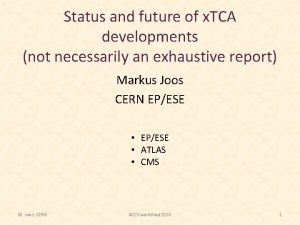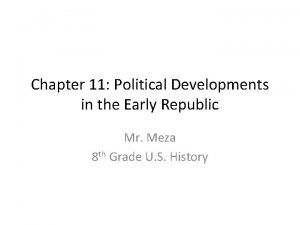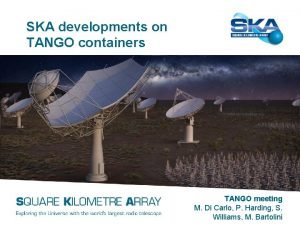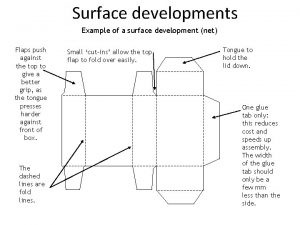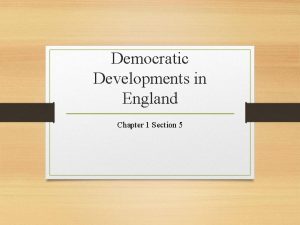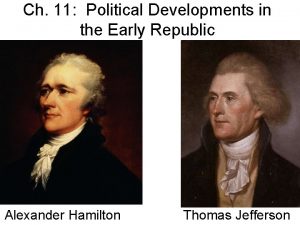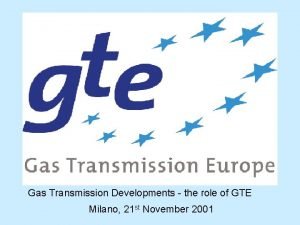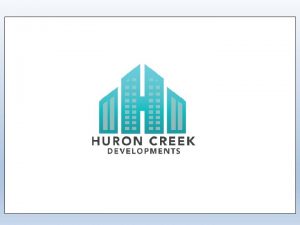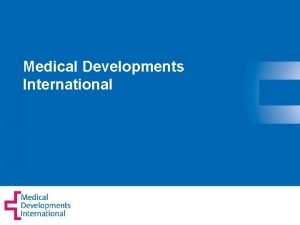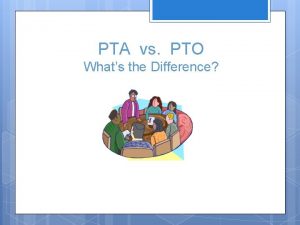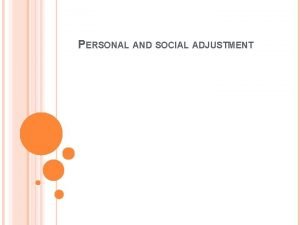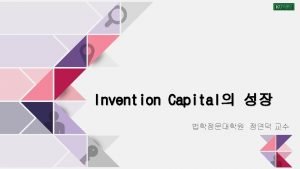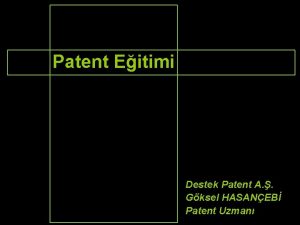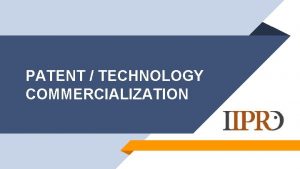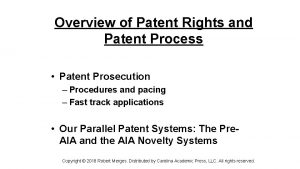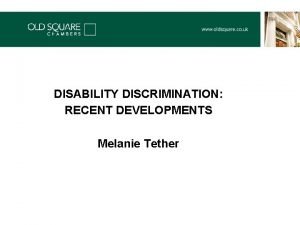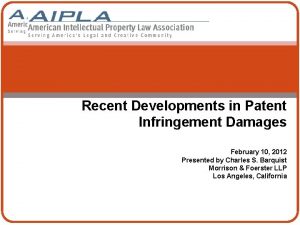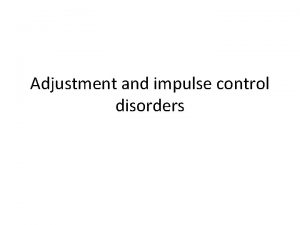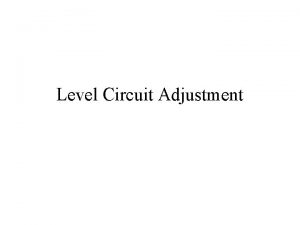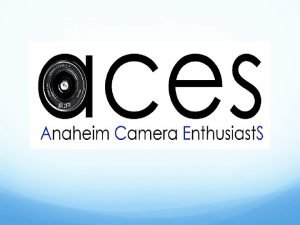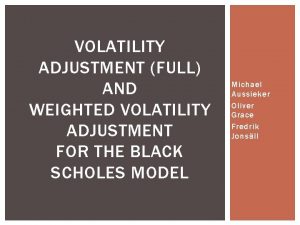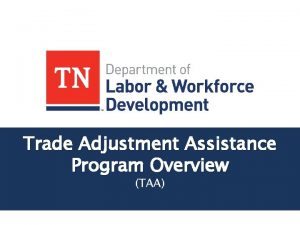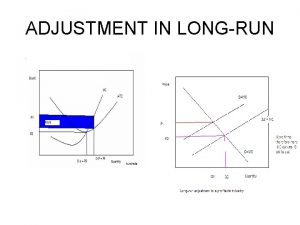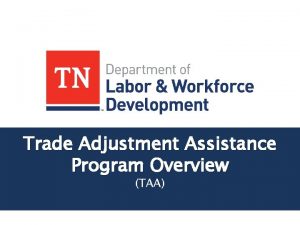Patent Term Adjustment PTA Recent Developments in PTA






































- Slides: 38

Patent Term Adjustment (PTA) Recent Developments in PTA Practice and Strategies for Maximizing PTA Presented to NJIPLA December 9, 2009 Jack Brennan Fish & Richardson P. C. New York

What Patents are Eligible for PTA? PTA Eligibility: – Applications filed on or after May 29, 2000 – For US national stage applications, the PCT filing date must be on or after May 29, 2000 Statute Governing PTA : – 35 USC 154(b) Rules Governing PTA : – 37 C. F. R. §§ 1. 702 - 1. 705 2

PTA Basics PTA = (Days of PTO Delay) – (Days of Applicant Delay) [if this number is less than zero, then zero days of PTA are assigned to the patent] Patentee can have days added to patent term (i. e. , PTA), but can never have days subtracted 3

PTO Delay 3 broad categories of PTO Delay: – “A delay” (failure of PTO to respond promptly to applicant submissions) – “B delay” (failure of PTO issue a patent within three years of filing) – “C delay” (others) 4

“A Delay” The PTO has: – – 14 months to issue 1 st action (RR or OA; not NTFMP) 4 months to respond to a response or appeal 4 months to issue action after BPAI decision 4 months to issue patent after issue fee payment “A Delay” starts accumulating on the day after a deadline date 35 USC 154(b)(1)(A) 5

How to Measure the Initial 14 Month Period for A Delay? Applications filed under 35 USC 111(a) – 14 months should be measured from actual filing date – PTO follows this in practice National stage applications filed under 371 – 14 months should be measured from completion of missing requirements – PTO follows this in practice 6

“B Delay” 3 -Years-to-Issue: – PTO has 3 years from application filing to issue a patent – “B Delay” starts accumulating on the day after the application has been pending for 3 years 35 USC 154(b)(1)(B) 7

How to Measure 3 Year Pendency for B Delay? Applications filed under 35 USC 111(a) – 3 year pendency should be measured from actual filing date – PTO follows this in practice National stage applications filed under 371 – 3 year pendency should be measured from when the national stage “commenced” – PTO does not follow this in practice (instead, measures from completion of missing requirements) – This is the “Japan Tobacco” error (reviewed in detail on later slides) 8

Events that Stop the 3 -Year Clock RCE: Filing an RCE stops the 3 -year clock forever – Applicant can get “B Delay” for time after 3 years but before the RCE filing date – 37 CFR 1. 703(b)(1) Interference: Declaration of interference or suspension of prosecution for possible interference stops the 3 -year clock until the interference or suspension is terminated – this time may be recovered as “C Delay” – 37 CFR 1. 703(b)(2) 9

Events that Stop the 3 -Year Clock Secrecy Order: Time consumed by imposition of a secrecy order – this time may be recovered as “C Delay” – 37 CFR 1. 703(b)(3) Notice of Appeal: Filing a Notice of Appeal stops the 3 -year clock until: (i) The last decision by the Board or a Federal court; or (ii) The mailing of a new office action or a notice of allowance (if the appeal did not result in a decision by the Board) – this time may be recovered as “C Delay” (only if appeal is “successful”) – 37 CFR 1. 703(b)(4) – PTO does not follow this in practice (instead, maintains 3 -year clock running after filing of a Notice of Appeal) 10

“C Delay” Delays resulting from: – Interferences – Secrecy Orders – Appeals (appeal must result in a final decision by the Board or a Federal court that is in favor of the applicant) 35 USC 154(b)(1)(C) 11

Recent PTO Errors in Calculating PTA Wyeth v. Dudas – How to calculate Overlap of “A” and “B” Delay – PTO is currently appealing an adverse district court decision Japan Tobacco (U. S. Patent No. 7, 465, 444) – How to measure the length of B Delay for 371 national stage filings – PTO has acknowledged this error and is working to fix it 12

How Does the PTO Calculate Overlap of “A” and “B” Delay? The statute prevents double-counting where there is “overlap” in “A Delay” and “B Delay” According to the PTO’s interpretation, the entire period during which an application is pending is used for determining whether periods of delay overlap (which means that a patentee gets A Delay or B Delay, whichever is larger) The court in Wyeth v. Dudas, 580 F. Supp. 2 d 138 (D. D. C. 2008) overruled the PTO’s interpretation 13

Wyeth v. Dudas Held: Patentee is entitled to the addition of “A Delay” and “B Delay” to the extent that they do not overlap A and B delays “overlap” only if they occur on the same day (which overlap can only possibly occur after the application has been pending for at least 3 years) This decision results in increased PTA for most patents that were pending for more than 3 years PTO appealed to Fed. Cir. on Nov. 28, 2008 Oral arguments on October 7, 2009 14

“Japan Tobacco” Issue How to measure 3 year pendency (for “B Delay”) for 371 national stage filings PTO: measures from completion of missing requirements Statute and Rules: measure from when the national stage “commenced” (usually the expiration of the 30 month from priority date time period) 15

B Delay Begins 3 Years After “Commencement” of the National Stage Start of the 3 year “B Delay” clock for a 371 filing depends upon whether the national stage commences under 35 U. S. C. 371(b) or (f) 35 U. S. C. 371(b) – U. S. national stage commences on the date that is 30 months from the priority date of a PCT application unless the applicant files an express request for early processing and completes the requirements of 371(c) prior to the 30 month date (see 371(f) below) 35 U. S. C. 371(f) – Commencement can occur before the 30 month date – Must file an express request for early processing and complete the requirements of 371(c) prior to the 30 month date 16

PTA Calculation for U. S. Patent No. 7, 465, 444 10/24/06 1 st Office Action 03/27/01 Priority App. (Japan) 12/16/08 ’ 444 Patent Issues 811 Days 5/4/05 1 st Office Action Due 02/18/02 PCT App. “B” Delay (JT) 538 Days 09/23/03 US Specification filed 27 Day Overlap “A” Delay 03/04/07 PTO: End of 3 year period 03/04/04 Application Complete 653 Days 3 years 30 months 09/27/03 JT: National Stage Commences “B” Delay (PTO) 3 years 09/27/06 JT: End of 3 year period 17

Timeline of Events in Challenging PTA for U. S. Patent No. 7, 465, 444 Patent granted December 16, 2008 – PTO awarded PTA of 653 days Request for PTA filed on January 8, 2009 (i. e. , within two months after patent grant) – PTA of 1, 322 days requested (Wyeth + JT) PTO Decision on Petition on June 16, 2009 – PTA request granted in part, denied in part – PTA changed to 811 days (JT granted, Wyeth denied) Renewed petition filed on July 15, 2009 – Requesting PTO to either follow Wyeth or hold a final decision in abeyance until Wyeth appeal decided 18

PTO has Recently Acknowledged the “Japan Tobacco” Error In July 2009, Fish and Richardson alerted the patent community to this error and the PTO’s acknowledgement of it for the ‘ 444 patent – http: //www. fr. com/news/articledetail. cfm? articleid=984 Several IP publications and blogs wrote articles on the topic – http: //www. patentdocs. org/2009/07/by-sydney-kokjohn---fish-richardsonand-its-pharmaceutical-client-japan-tobacco-inc-recently-discovered-another -error-in-t. html On September 9, 2009, the PTO issued a formal notice acknowledging that they incorrectly calculate three year pendency for 371 filings and they are “in the process” of correcting the problem – Patentees must file a request for correction within 2 months after patent grant 19

Hypothetical Applications of the “Japan Tobacco” Rule Example of PTO Practice Awarding Too Little PTA – Request for U. S. national stage application filed on or around 30 month deadline – Declaration filed at a later date (after 30 month period expires) – PTO incorrectly starts 3 year clock late based on completion of 371(c) Example of PTO Practice Awarding Too Much PTA – Request for U. S. national stage application and all requirements of 371(c) filed before 30 month deadline – No express request for early processing filed – PTO incorrectly starts 3 year clock early based on completion of 371(c) – Patentee must inform PTO if too much PTA is awarded 20

Applicant Delays Result from failure of applicant to “engage in reasonable efforts to conclude prosecution of the application” The PTO regulations identify many circumstances that constitute “failure to engage” 21

Common Applicant Delays Filing a reply more than 3 months after action mailing date – Every day after the 3 -month date (weekend, holiday, snow day, etc. ) counts as 1 day of applicant delay, EVEN if action says deadline is otherwise (e. g. , filing a response on a Monday when the 3 month due date is Saturday will cost 2 days of Applicant Delay) – Date of receipt at the PTO is what matters for PTA purposes – The period set by PTO for reply does not matter for purposes of Applicant Delay (e. g. , no Applicant Delay if a reply to an action with a 1 month response deadline is filed at the 3 month date with a 2 month extension) 22

Common Applicant Delays (ctd. ) Submission of incomplete reply – e. g. , non-responsive amendments, non-compliant amendments Submission of supplemental reply – IDS after response to Office Action is a “supplemental reply” unless … • It is filed within 30 days of mailing date of a foreign action in a counterpart foreign application; • all art was first cited in the foreign action; and • it is accompanied by a certification under 37 C. F. R. § 1. 704(d) 23

Effect of Filing a Terminal Disclaimer A patent that has been disclaimed beyond a specified date cannot be adjusted beyond the date in the disclaimer – 35 USC 154(b)(2)(b) Although filing a terminal disclaimer can reduce or eliminate PTA for a patent, the PTO does not actually make a PTA calculation based upon the term of the other patent – The face of the issued patent states “subject to any disclaimer, the term of this patent is extended or adjusted under 35 U. S. C. 154(b) by x days” 24

Strategies for Maximizing Patent Term in View of PTA Rules Avoid accumulating Applicant Delay whenever possible Avoid stopping the 3 year clock Avoid filing unnecessary terminal disclaimers File complete national stage applications Be aware of circumstances that can result in accumulation of PTO Delay 25

Avoid Accumulating Applicant Delay Whenever Possible File all responses on or before three month date (and don’t use weekend or holiday carry-overs) Avoid supplemental responses (unless expressly requested by the Examiner) Avoid incomplete or non-compliant replies Always file documents with the PTO electronically or by express mail 26

Avoid Accumulating Applicant Delay Whenever Possible (ctd. ) IDS’s should be filed: – before receipt of a first action; – with a reply to a non-final action; or – Within 30 days of mailing date of foreign action (with certification under 37 C. F. R. § 1. 704(d)) An IDS filed after a response to Office Action or Restriction Requirement and without a certification under 37 C. F. R. § 1. 704(d) will be treated as a “supplemental reply” – Every day after filing of response until filing of IDS will be Applicant Delay (e. g. , response to office action filed at 2 month date and IDS at 3 month date = 1 month Applicant Delay) 27

Avoid Stopping the 3 Year Clock Avoid filing RCEs (doing so permanently stops the 3 year clock) Consider after-final strategies that result in either a Notice of Allowance or the issuance of a non-final office action Consider an appeal or a petition to have finality withdrawn (if appropriate) Note: RCEs filed on or after Nov. 15, 2009 are placed on examiner’s special new application docket (if Examiner takes more than 4 months to act, then “A Delay” will accrue) 28

Avoid Filing Unnecessary Terminal Disclaimers Filing a terminal disclaimer can limit PTA (term cannot extend beyond that of the earlier patent) Also, maximize PTA while prosecuting all applications, because even if Patent A is not commercially important, it could nonetheless limit the term of Patent B if a terminal disclaimer must later be filed over Patent A (so the longer the term of Patent A the better) 29

File Complete National Stage Applications Results in the 14 -month clock starting immediately with application filing (can result in greater accumulation of “A Delay”) Eliminates any potential clash with the PTO systemic error of starting the 3 -year clock (for purposes of “B Delay”) only upon completion of missing requirements 30

Circumstances that can Result in Accumulation of PTO “A Delay” Generally, Applicant’s actions do not affect PTO’s reply time However, filing some petitions/requests may cause the PTO to exceed their time requirements (e. g. , requests to correct PTA filed after allowance often delay patent issuance beyond 4 months) Under new PTO docketing procedures, RCEs may trigger “A Delay” in some cases 31

Circumstances that Can Result in Accumulation of PTO “B Delay” Application pendency time is mostly within the control of the PTO However, Applicant’s use of the full 3 month response periods (even for NTFMP and RR, with extensions of time) may have an effect on pendency time for some applications (without triggering Applicant Delay) 32

What are the Deadlines for Correcting PTA? At Allowance… – Requests covering any pre-allowance PTA error must be filed no later than payment of issue fee At Issuance… – Requests may only cover PTA errors that could not have been corrected at allowance – Requests must be filed within 2 months after issue date Letters re PTA… – Duty to notify PTO if too much PTA awarded – No deadline except “due course” Note: Requests to Correct PTA do not trigger Applicant Delay, even if unsuccessful 33

How to Handle PTO’s Rejection of Wyeth-Based Applications for PTA? Administrative Process: 1 st, patentee files Application for PTA within 2 months after patent grant 2 nd, PTO issues a decision rejecting Application for PTA 3 rd, patentee files response to decision, requesting PTO to follow Wyeth or hold final decision in abeyance until completion of Wyeth appeal 4 th, PTO issues a final decision (content of final decision TBD, based on outcome of Wyeth appeal) District Court: file suit no later than 180 days after patent grant 34

Filing Suit in District Court to Correct PTA Must file application for PTA with PTO before going to court Must file suit in district court by 180 days after patent grant even if no response to application for PTA filed with PTO Failure to file suit could result in inability to have PTA corrected To minimize litigation costs, can file a few PTA suits per year with multiple patents 35

Will the PTO Provide a Retroactive Remedy? If Wyeth upheld on appeal? To address the Japan Tobacco issue? From a PTO denial of a petition to accept a “late” request for PTA – “upon ultimate resolution of the interpretation of 37 CFR 1. 702, justice requires that the Office determine consistent with relevant law and practice, and appropriate Court or legislative guidance, the applicability of any changes as to all affected patentees who failed to timely seek administrative remedy, and thus, could not seek judicial review” 36

Precedent for a Retroactive PTA Remedy PTO amended PTA rules to reverse its position that a remand from the Board of Patent Appeals and Interferences could not be a “decision” – PTO provided a two month period (beginning on the date of publication of a notice in Federal Register) in which patentees whose patent term would have been calculated differently could file a request for reconsideration under the revised rule – Revision of Patent Term Extension and Patent Term Adjustment Provisions” published on April 22, 2004 at 69 Fed. Reg. 21704 -11 37

The End Thank you!
 Recent developments in ict
Recent developments in ict Recent developments in object detection
Recent developments in object detection In the colonial era developments such as the new england
In the colonial era developments such as the new england Cultural development of sahelanthropus tchadensis brainly
Cultural development of sahelanthropus tchadensis brainly Comtel atca
Comtel atca Political developments in the early republic
Political developments in the early republic Donmeg developments
Donmeg developments Target developments
Target developments Peter rosenwald
Peter rosenwald Cplim
Cplim Democratic developments in england
Democratic developments in england What is surface development
What is surface development Democratic developments in england
Democratic developments in england 8 patterns of development in writing
8 patterns of development in writing Political developments in the early republic
Political developments in the early republic Name of prism
Name of prism Transmission developments
Transmission developments Pattern development engineering
Pattern development engineering Huron creek developments
Huron creek developments Mdi vision
Mdi vision After miguel's recent automobile accident
After miguel's recent automobile accident Sports news in passive voice
Sports news in passive voice Ap synthesis prompt
Ap synthesis prompt Comait
Comait Recent demographic changes in the uk
Recent demographic changes in the uk Https drive google com drive u 0 recent
Https drive google com drive u 0 recent A friend emails you the results of a recent high school
A friend emails you the results of a recent high school Explain recent trends in foreign trade of india
Explain recent trends in foreign trade of india Schoology myips
Schoology myips Udin generate icsi
Udin generate icsi Importance of scanning and skimming
Importance of scanning and skimming Geotaphonomy
Geotaphonomy Recent advances in ceramics
Recent advances in ceramics Recent trends in ic engine
Recent trends in ic engine Recent trends in mis
Recent trends in mis Recent trends in project management
Recent trends in project management Difference between pta and pto
Difference between pta and pto Ninth district pta
Ninth district pta Pta 2
Pta 2




